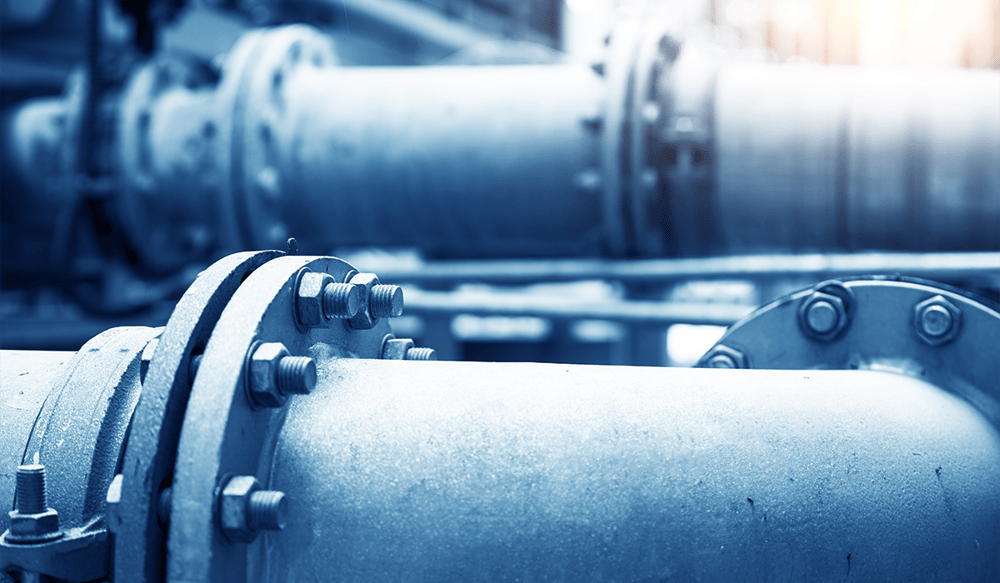
There’s an invisible yet costly force running through your pipe system: energy. Every ounce of energy that slips through the nooks and crannies of your system is money wasted.
It’s time to reclaim this precious commodity.
Ready to reduce energy, save money, and improve your pipe system’s performance? We’re here to help. Here are four ways to increase energy efficiency in your pipe system.
1. Insulate Your Pipes
Energy and heat can be tough to hang on to. Because metal is conductive, it can be a gateway for energy to escape from inside your pipes. In some cases, energy will jump across pipes and transfer into surrounding metal structures, such as I-beams. That’s why insulation is crucial if you want to stop energy from fleeing your pipe system.
By adding insulation, you can keep energy where it belongs—flowing through your pipes. Conveniently, you have a few options when it comes to insulating your pipes:
Pre-Insulated Pipe Supports
One insulation option is to install pre-insulated pipe support. These supports include built-in liners that separate metallic supports from the metal of pipes. For instance, in the case of pre-insulated pipe shoes, supports include a layer of nonmetallic material that separates the metal of the shoe from the metal of the pipe. That cushion keeps energy from jumping into surrounding metals.
Isolators
You can also insulate pipes by adding isolators. These pipe supports act as a buffer between your pipes and surrounding metals. Here are some popular examples of isolators:
2. Prevent Corrosion Throughout Your Pipe System
Corrosion doesn’t just pose an immediate threat to your system’s longevity. It can also suck energy out of your pipe system.
When corrosion sets in, it can cause your supports to break down. Every time a support falls apart, the rest of the pipe system has to pick up the slack. In the end, that means your system has to generate more energy to do the same amount of work.
Wondering how to keep corrosion from pulling energy out of your pipe system? Try these anti-corrosion techniques:
Add Galvanization
During the galvanization process, you add a layer of zinc to metals that are vulnerable to corrosion. This strengthens metal and helps to keep surfaces from rusting.
Use Sealants
Especially in grimy or salt-heavy environments, corrosive materials can seep into crevices. From there, corrosion can spread and weaken your pipe system. By adding a silicone sealant to piping gaps, you can keep corrosion from sliding into these vulnerable metallic openings and destroying pipes.
Reduce Abrasion
As pipes shift and slide across other metal surfaces, it can wear them down. When surfaces break down, it causes crevice corrosion and ruptures. You can reduce friction damage by installing pipe restraints, wear pads, pipe shoes, or other pipe supports that allow pipes to move more fluently.
3. Keep Pipes Clean and Clear of Blockages
If you want to reduce energy usage, it’s important to provide a clear path for energy to flow smoothly through pipes. Unfortunately, blockages can disrupt that journey. Any time fluids have to work harder to get around debris, corrosive dips, or uneven surfaces, it takes extra oomph to push liquids on. And that burns precious energy.
Here are some ways to keep pipes flowing without interruptions:
- Clean pipes regularly and monitor energy use
- Add water proofing or drainage in areas that are susceptible to pooling
- Adjust pipe runs to avoid sagging or drooping
4. Be Picky About Materials
The materials you use throughout your pipe system can affect how much energy it retains. This is an area in which composite materials can make a big difference. Composite pipe supports help reduce energy waste in two major ways:
Heat Transfer
Especially in cold or high-performing systems, energy can streak across metal surfaces. In cold systems, that can lead to ice formation and destructive pipe movement. However, composite supports, such as composite pipe shoes, don’t absorb heat the way metal does. That means, in addition to supporting pipes, they stop energy from escaping through surrounding metallic surfaces.
Installation Energy
There’s more to energy efficiency than controlling what’s running through your pipes. Travel, installation labor, and hauling equipment to a job site all take an extra dose of energy. Most composite pipe supports are simple to install and don’t require heavy equipment. That reduces the amount of energy you need to put into your system in order to get things up and running.
Control Pipe Movement & Improve Your Pipe System’s Efficiency
Controlling pipe movement is at the heart of energy-efficient pipe systems. And pipe restraints are designed to give you control over how your pipes move.
Want to learn how you can use pipe restraints to get more out of your pipe system? Read our Complete Guide to Pipe Restraints and learn everything you need to know about these essential supports.






